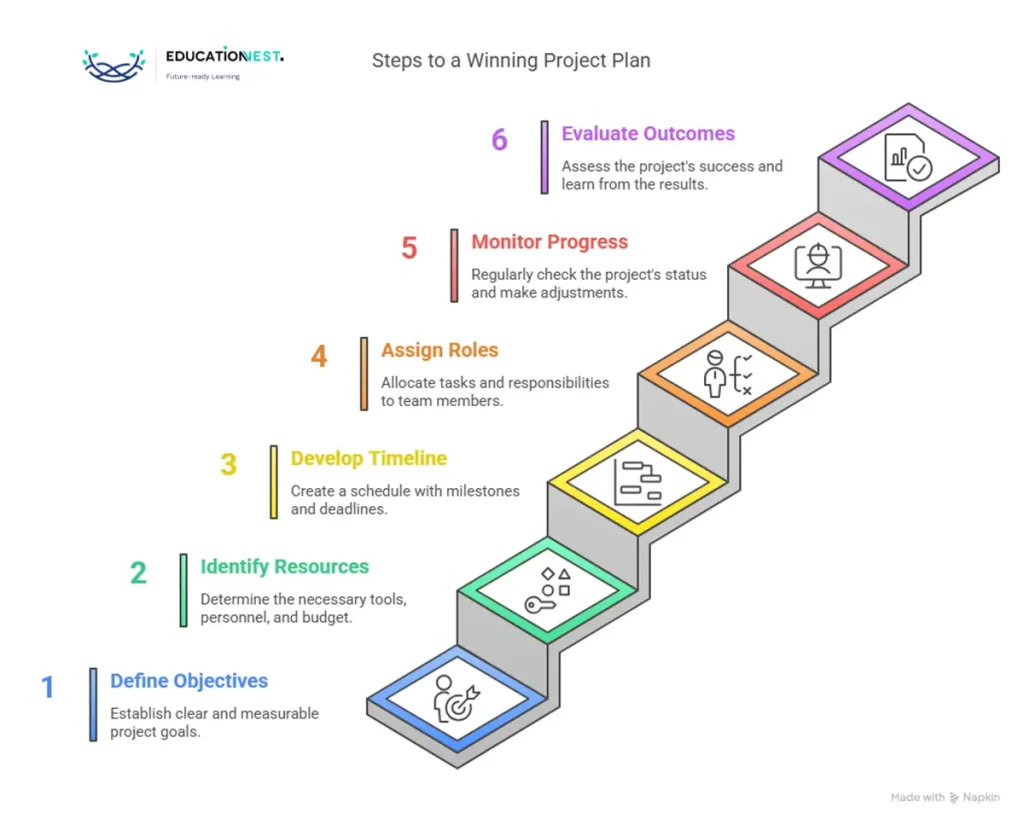A well-thought-out project plan can be the difference between success and failure. There is a right way to write a solid project plan. The keyword here is “winning.” We cannot stress this enough no matter if you are managing a small team or a large-scale project.
A detailed plan gives your team clear direction even in times of extreme confusion. This single blueprint will guide every step of the way to the success of the project. In this blog, we walk you through a simple, step-by-step guide to writing a winning project plan that will never fail you!
Define Your Goals
Every project has a purpose. Yours might be to launch a new item or improve an existing process. But how will you know if you have succeeded if you don’t define what success looks like?
The difference between project goals and objectives is simple. Goals are your big-picture outcomes. Objectives are the smaller measurable actions you take to reach those goals.
A successful project starts with clear goals. Goals give your project direction and keep everyone focused. It also motivates the team when they see how their work adds up to the bigger picture. They are more likely to be committed.
Set Success Metrics
Success metrics are important components of a project plan. They help you track whether you are on the right path. Using SMART goals is the best method to do this. If your goal is to host a conference, a success metric could be to have at least 1000 attendees. This makes it clear and measurable. So you can check at the end if you hit your target.
Clarify Stakeholders and Roles
A project involves many people and each has a unique part to play. The role of a project manager is to avoid confusion and ensure everyone knows their responsibilities. Hence, your plan must clearly list the responsibilities of each person. This will help everyone be on the same page about who is in charge of what and avoid gaps in responsibility.
Most often, the project manager (sometimes the sponsor) decides the key players. You can use the RACI chart to help clarify these four things – who makes decisions, who handles tasks, who needs to be kept in the loop, and who simply needs to stay informed.
Set Your Budget
Every project requires a budget. Whether it is for hiring extra help, buying materials, or booking venues. Set a budget during the early phases of planning so that you don’t run into financial surprises later.
Your budget should cover the scale of your project. If you expect 1000 people to show up to your event, your spending should be enough. It should be enough to cover marketing, speakers, and venue for that many people. You need to be as realistic as possible. Budget planning in project management ahead of time helps you get easy approvals and track spending throughout the project.
Resource Allocation
Resource allocation is a simple concept. You will need to keep the right person and tools (not to forget, the funding) available in the right place at the right time. If you are wondering how to allocate resources correctly in a project, you can follow these steps.
- List what you need – the resources your project will need. This can be your team, software, or raw materials (plus the budget).
- Match resources to tasks. Figure out “what” is needed for each task. If your task is creating marketing materials, you will need graphic designers, some software, and maybe some freelancers too. Assign the right people and tools to each task (based on expertise).
- Avoid overloading your team. It is tempting to assign tasks to your busiest or most capable team members. But this can lead to burnout. Balance workloads so that no one is stretched too thin.
- Track your budget. Set aside funds for each part of your project. This is the right way to monitor the project budget as you go. If your project involves multiple departments, ensure everyone knows how costs will be split.
- Stay adaptable. Just like timelines, resource needs can change. A task might take longer than expected, or you might need extra help. Stay prepared for changes that you might need to make as you move deep into the project.
This is a big part of project management training where most managers go wrong. If you have noticed your managers struggling with this step, it might be best to refresh their skills. EducationNest, India’s top corporate training provider, can help you train your in-house team of project managers with the help of comprehensive courses led by expert trainers to deliver results.

Read More
The Future of Work: Exploring Microsoft Copilot’s Impact on Employee Productivity
Steps to Get Started with Python for Web Development
Milestones & Deliverables
One of the most important steps in writing a project plan is to set milestones. You cannot miss this step if you want to track progress the right way. If you are developing a new product, one milestone might be when the prototype is completed. This gives your team something to work towards. It helps everyone see the project is moving in the right direction.
Deliverables are the tangible results. In the example of product development, the deliverable would be the prototype. You will also need to define task dependencies. These are things that need to happen before other tasks can begin. For example, you cannot start prototype testing until the design is approved.
Timeline and Schedule
The next step is to put everything on a timeline. A clear schedule will be necessary for tracking progress. On top of that, your stakeholders also need to know the time for project completion.
Start by breaking the project into smaller tasks. Assign start and end dates to each one. If you are dealing with a large project with unclear dates, you can simply create a project roadmap to outline the order of tasks instead of exact dates. Stakeholders can be given a copy of this plan.
Communication Plan
You cannot move ahead without communicating with your team. To put everyone on the same page, you need to define how everyone will communicate regarding the project. You will have to decide how often you will meet.
Everyone needs to know how updates will be shared. You need to list down the channels that will be officially used to speak to each other. Project management tools like Slack, Trello, or Asana help keep everything in one place.
Conclusion
Ever worked on a project where deadlines keep slipping, tasks are out of order, and it feels like everyone’s running in circles to catch up? A solid project plan can make all the difference.
Good planning leads to good results! This blog explains in detail the 7 key steps to writing a killer project plan that can turn your chaos into order. While this is only the start, project management is an art that can be learned through proper training.
If you are looking to infuse these essential project management skills into your managers, the best way is to invest in a comprehensive corporate training program. This will help you fill all the gaps that your existing project managers have and also help build new skills.
If you were planning something similar, you are at the right place. EducationNest is India’s top corporate training provider that has helped numerous companies across India in their training efforts. They have numerous courses covering soft skills, digital marketing, cybersecurity, AWS, and more that are all led by experts and can deliver you the exact results your company needs!
